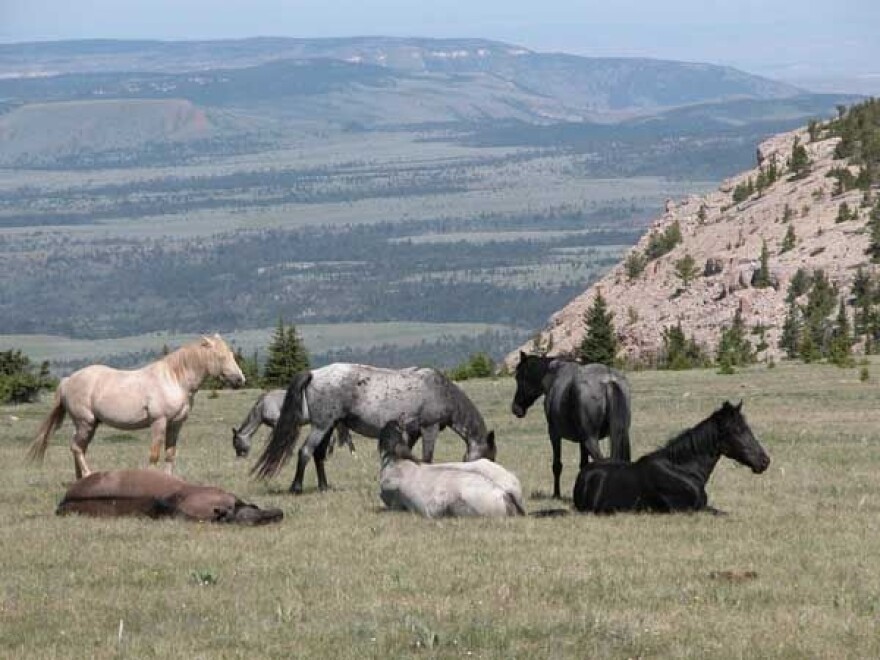As part of Wyoming Public Media’s ‘I respectfully disagree’ series, four panelists discussed issues surrounding wild horses in the state on a Facebook live.
Stakeholders spoke for an hour about topics like herd management, fertility control and holding facilities.
The panelists were Suzanne Roy, the executive director of the American Wild Horse Campaign; Brian Boner, a Wyoming senator representing District 2; Christi Chapman, the director and co-founder of Wyoming Wild Horse Improvement Partnership; and Erik Molvar, the executive director of the Western Watersheds Project.
One issue the panelists focused on was whether cattle or wild horses should have priority on public lands.
Boner said wild horses have to be managed at lower numbers in order for ranching to continue to thrive
“These ranchers in these parts of the state have been doing this for a very long time. It's a part of our heritage, as well as a part of our economy, and we need to strike a balance, that includes having ranchers have the ability to make a living and still have wild horses,” he said.
But, Roy said that in areas where wild horses roam, they need to have priority.
“In the world where we're losing so much of wildness, like, that matters, and people want to see that. And the horses are really an integral part of that,” Roy said. “In Wyoming and elsewhere in the West, we still have a corner of the West where wild horses still run free. That is really cool. That’s something we should save.”
The panelists did find some common ground regarding the checkerboard land issue in southwestern Wyoming. This is where there are alternating one-mile sections of public and private land.
It has resulted in over a decade of legal battles between the landowners and the Bureau of Land Management (BLM). The BLM is currently proposing some solutions to wild horses roaming on private lands. One option includes reducing herd sizes significantly in several herd management areas and eliminating horses in other areas by roundups and relocation.
Molvar said the ideal resolution is not to reduce herd sizes, but to do a land swap between private owners and the BLM that would consolidate public land into a larger area.
“The wild horses could be kept on the public lands, and they could easily not be allowed to go on to the private lands,” Molvar said.
Boner said as a rancher and land owner he would find a land swap beneficial. In fact, he said it is something the legislature has explored with other issues like oil and gas development.
“We've looked at it from the state's perspective as well to do a land swap with the federal government to make sure that we can enter the greatest benefit for those trust beneficiaries for our state lands,” Boner said.
Panelists also discussed how to address population control of wild horses. Roy and Molvar said the land can actually handle more wild horses than the BLM manages. Currently the BLM manages 3,725 wild horses on five million acres in the state.
“We'd like to see the return of native predators, like wolves, like mountain lions, bears into these landscapes, because these are the natural predators of wild horses,” Molvar said. “And in other states, where these types of predators occur, you see pretty significant predation on wild horses and, and we'd like to see a more natural balance on public lands, and in cases where natural solutions can be the solution.”
But Chapman disagreed. She said things like predation and fertility control can help with herd sizes, but it is not the solution.
“There is a thriving population of grizzly bears and wolves and mountain lions on the Wind River Reservation private holdings. And yet, their numbers [of horses] are considerably higher than what the rest of the state is,” Chapman said. “So we have to look at the whole picture.”
Chapman said gathering the wild horses to reduce herd sizes is part of the solution.
To listen to the full conversation click here.
Copyright 2022 Wyoming Public Radio. To see more, visit Wyoming Public Radio. 9(MDAxNDQ2NDAxMDEyNzU2NzM2ODA3ZGI1ZA001))





